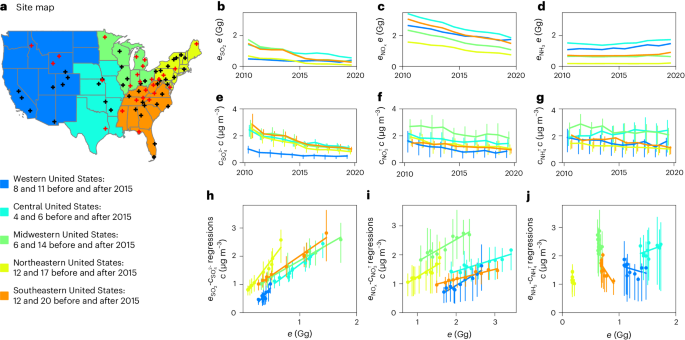20024-08-22 プリンストン大学
<関連情報>
- https://engineering.princeton.edu/news/2024/08/22/cuts-air-pollution-increased-pollution-ground-level
- https://www.nature.com/articles/s41561-024-01455-9
米国農村部における二次無機エアロゾル形成と窒素沈着におけるレジームシフト Regime shift in secondary inorganic aerosol formation and nitrogen deposition in the rural United States
Da Pan,Denise L. Mauzerall,Rui Wang,Xuehui Guo,Melissa Puchalski,Yixin Guo,Shaojie Song,Daniel Tong,Amy P. Sullivan,Bret A. Schichtel,Jeffrey L. Collett Jr & Mark A. Zondlo
Nature Geoscience Published:20 June 2024
DOI:https://doi.org/10.1038/s41561-024-01455-9

Abstract
Secondary inorganic aerosols play an important role in air pollution and climate change, and their formation modulates the atmospheric deposition of reactive nitrogen (including oxidized and reduced nitrogen), thus impacting the nitrogen cycle. Large-scale and long-term analyses of secondary inorganic aerosol formation based on model simulations have substantial uncertainties. Here we improve constraints on secondary inorganic aerosol formation using decade-long in situ observations of aerosol composition and gaseous precursors from multiple monitoring networks across the United States. We reveal a shift in the secondary inorganic aerosol formation regime in the rural United States between 2011 and 2020, making rural areas less sensitive to changes in ammonia concentrations and shortening the effective atmospheric lifetime of reduced forms of reactive nitrogen. This leads to potential increases in reactive nitrogen deposition near ammonia emission hotspots, with ecosystem impacts warranting further investigation. Ammonia (NH3), a critical but not directly regulated precursor of fine particulate matter in the United States, has been increasingly scrutinized to improve air quality. Our findings, however, show that controlling NH3 became significantly less effective for mitigating fine particulate matter in the rural United States. We highlight the need for more collocated aerosol and precursor observations for better characterization of secondary inorganic aerosols formation in urban areas.



